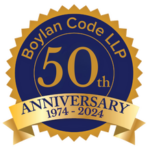Devin Lawton Palmer, Esq.
1) Route 21 Associates of Belleville, LLC v. Millennium Custodial Trust (In re Lyondell Chemical Co.), 2013 U.S. App. LEXIS 21471 (2d Cir. Oct. 23, 2013):
How are claims arising from a debtor’s rejection of an executory contract treated in bankruptcy?
With little in the way of facts, the Second Circuit found that when an executory contract is properly rejected in bankruptcy under section 365 of the Bankruptcy Code, the court shall treat the contract as if it was breached immediately before the bankruptcy filing. As such, a claim arising from the breach shall be deemed a pre-petition claim. Over the creditor’s objection, the Court found that as a breach of contract the pre-petition obligations owed the creditor could be reduced to a claim for damages. As such, the creditor was left with only a distribution under the plan (“if the obligation is not one that can be reduced to a claim for damages it cannot be discharged in bankruptcy, and the debtor retains the obligation despite the bankruptcy filing”). The Court also rejected the creditor’s argument that its damages were entitled to an administrative priority. The Second Circuit wrote that “statutory priorities are narrowly construed” and “here, the agreements at issue were all entered into pre-petition.” The fact that some of the costs were incurred post-petition did not change the fact the creditor was entitled to only a pre-petition unsecured claim pursuant to 11 U.S.C. §§ 365 and 502(g)(1).
2) Thomas v. Barrett, 2013 U.S. App. LEXIS 19361 (2d Cir. Sept. 18, 2013):
Can a debtor directly sue a defendant on a claim that is part of the debtor’s bankruptcy estate without the permission of the trustee?
The Second Circuit affirmed the District Court’s orders dismissing the Plaintiff’s complaint for lack of standing. Unfortunately, the Court began with an assumption that the parties were familiar with the underlying facts, leaving little for third-party readers. However, the basis for dismissal was that the cause of action was property of the Debtor’s bankruptcy estate as it was “derived from property that was part of the estate.” The Court cited section 541(a)(1) of the Code and emphasized that “the bankruptcy estate includes future, nonpossessory, contingent, speculative and derivative interests, along with all causes of action ‘owned by the debtor or arising from property of the estate.’”
“Where legal claims become part of a bankruptcy estate, the debtor lacks standing to bring these claims, in the absence of circumstances not present here.”
UPDATE: the claims were based on the Defendants’ fraudulent notices issued to the Debtor alleging note/mortgage default and demanding money when, in fact, no debt was due. These written notices were mailed pre-petition and the Debtor’s claim of potential damages based thereon was not included in her bankruptcy schedules. “To the extent that some of her claims involve some post-petition conduct, such as reporting her prepetition debt to credit bureaus, they are sufficiently rooted in the pre-bankruptcy past and so little entangled with [Thomas’s] ability to make an unencumbered fresh start that [they] should be regarded as property of the estate.” Thomas v. JP Morgan Chase, N.A., 2012 U.S. Dist. LEXIS 96131 (E.D.N.Y. July 11, 2012).
3) Hamm v. PHH Mortgage Corporation (In re Hamm), AP No. 11-1109 / BK No. 11-11648 (Bankr. W.D.N.Y. Bucki, C.J., Sept. 18, 2013):
Can a debtor sustain its second cause of action based on the allegations contained in its first cause of action that was earlier dismissed?
The Debtor’s mortgagee (PHH Mortgage Corp.) required the Debtor attain private mortgage insurance in connection with PHH’s loan and mortgage on the Debtor’s residence. The PMI was issued by United Guaranty. To reduce its exposure, United Guaranty purchased reinsurance coverage from Atrium Insurance Corp., an acknowledged subsidiary of PHH.
Following the Debtor’s mortgage default, but before the foreclosure sale, she filed Chapter 13 bankruptcy. Therein, the Debtor commenced an Adversary Proceeding against PHH, United Guaranty and Atrium for a violation of Insurance Law § 6504 and New York Banking Law § 6-l.
The Court began with New York’s Insurance Law which reads in part, “in connection with the placement or renewal of any insurance, a mortgage insurer shall not permit any compensation to be paid to, or received by: any insured lender…or other entity in which an insured…has a financial interest.” NY Ins. Law § 6504(c). Here, United Guaranty and PHH are the mortgage and insurer and insured lender. The Court agreed that by reason of its payment of reinsurance premiums to Atrium (a clear subsidiary of PHH), United Guaranty may have violated section 6504’s prohibition against payment of compensation to an entity in which the insured has a financial interest. Unfortunately, New York’s Insurance Law does not include a private right of action for the Debtor. Therefore, the Debtor’s first cause of action based entirely therein must be dismissed.
Turning to the Debtor’s second cause of action, the Court reviewed Banking Law § 6, which imposes special underwriting and disclosure requirements for loans that qualify as “high-cost home loans.” If the Debtor’s loan qualified, PHH would have violated the Banking Law by making the loan without regard to the Debtor’s ability to pay and for failure to provide certain statutory notices. The Debtor conceded that for her loan to meet this standard, the reinsurance portion of her private mortgage insurance must be considered a point or fee .
The Court agreed with the Defendants that premiums for private mortgage insurance appear to be excluded from the definition of “fees” and “points” under the Banking Law. However, if the instant PMI fails to comply with section 6504 of the Insurance Law (as alleged in the Debtor’s first cause of action), its premiums may not fully qualify for that exclusion. The Court noted that by essential insuring itself, the PMI looked less like insurance and more like an additional fee. By including an initial paragraph in the Debtor’s second cause of action that incorporated all of the prior allegations in the Complaint (including those found in the first cause of action), the Debtor’s second claim for relief was sufficiently pled.
Based on the foregoing, the Court denied the Defendants Motion as it applied to the second cause of action bottoming upon Banking Law section 6.
4) Wong v. Green Tree Servicing, LLC and Mortgage World Bankers, Inc. (In re Wong), 488 B.R. 537 (Bankr. E.D.N.Y. 2013):
Can a debtor who is ineligible to receive a discharge still be allowed to avoid a wholly unsecured junior lien under section 1322(b)(2)?
In a very thorough decision, the Bankruptcy Court discussed the interrelation of mortgage modification decisions such as U.S. v. Ron Pair, 489 U.S. 235 (1989), Nobelman v. American Sav. Bank, 508 U.S. 324 (1993), Dewsnup v. Timm, 502 U.S. 410 (1992), In re Pond, 252 F. 3d 122 (2d Cir. 2001).
Here, the Debtor received a Chapter 7 discharge on April 5, 2011 and then turned around and filed for relief under Chapter 13 in January 2012. He was therefore, ineligible to receive a discharge in the 13 pursuant to 11 U.S.C. § 1328(f) (receipt of a chapter 7 discharge within 4 years). The purpose of the Chapter 13 was simply to strip away the wholly unsecured mortgage liens of Green Tree Servicing ($198,000) and Mortgage World Bankers ($25,000) from the Debtor’s $350,000 residence that was already encumbered by a $393,500 first mortgage.
While the mortgagees themselves sat silent, the Chapter 13 Trustee objected citing several decisions holding section 1322(b)(2) unavailable for an ineligible debtor. Perhaps most persuasively, the Trustee highlighted section 1325(a)(5)(B)(i)(I) of the Code, which requires for the confirmation of a plan as to an “allowed secured claim” that the holder of such claim retain the lien securing the claim until the earlier of (aa) payment of the debtor; or (bb) discharge under 1328 – a discharge that this Debtor was ineligible to receive.
The Court began by reviewing section 1328 and finding that while it clearly prohibited the Debtor from receiving a discharge it did not impede his attempt to confirm a plan or modify a mortgage within Chapter 13. In addition, 11 U.S.C. § 109 (“Who may be a debtor”) does not render an individual who is ineligible for a discharge ineligible for Chapter 13 relief.
Turning to the aforementioned Supreme Court decisions the Court found that since the collateral in question did not have enough value to even secure a portion of the Defendants’ liens, the liens were wholly unsecured pursuant to 11 U.S.C. § 506. Under section 1322(b)(2) of the Code, a Chapter 13 Plan may “modify the rights of holders of secured claims, other than a claim secured only by a security interest in real property that is the debtor’s principal residence…” As the Second Circuit held in In re Pond, the antimodificaiton exception of section 1322(b)(2) protects a creditors rights in a mortgage lien “only where the debtor’s residence retains enough value – after accounting for other encumbrances that have priority over the lien – to that the lien is at least partially secured under section 506(a)…[accordingly,] a wholly unsecure claim, as defined under section 506(a), is not protected under the antimodification exception.” In re Pond, 252 F.3d 126. Since the claims of Green Tree and Mortgage World were wholly unsecured, the Debtor here could avoid the Defendants’ lien and treat their claims as unsecured in his Chapter 13 plan, despite the fact these liens were on the Debtor’s residence.
Finally, over the Chapter 13’s objections, the Court found that section 1325(a)(5) of the Code (prohibiting lien avoidance until discharge) was not applicable to a claim that is unsecured pursuant to section 506(a). Under the same rational used in Pond, the claims of Green Tree and Mortgage World were not an “allowed secured claim” – the limited claims to which 1325(a)(5) applies. As such, the Defendants were not allowed the benefits afforded secured creditors therein, including the retention of a creditor’s lien on a debtor’s property until discharge.
Based on the foregoing, the Court granted the Debtor’s application and determined Green Tree and Mortgage World were unsecured creditors under section 506(a) and therefore, unsecured for purposes of sections 1322(b)(2) and 1325(a)(5). The Debtor could therefore, confirm a plan that provided for the avoidance of the liens securing the Defendants’ claims pursuant to section 1322(b)(2).
[1] The total points and fees surpass “five percent of the total loan amount if the total loan amount is fifty thousand dollars or more.” NY Banking Law § 6-i(1)(g)(ii).


